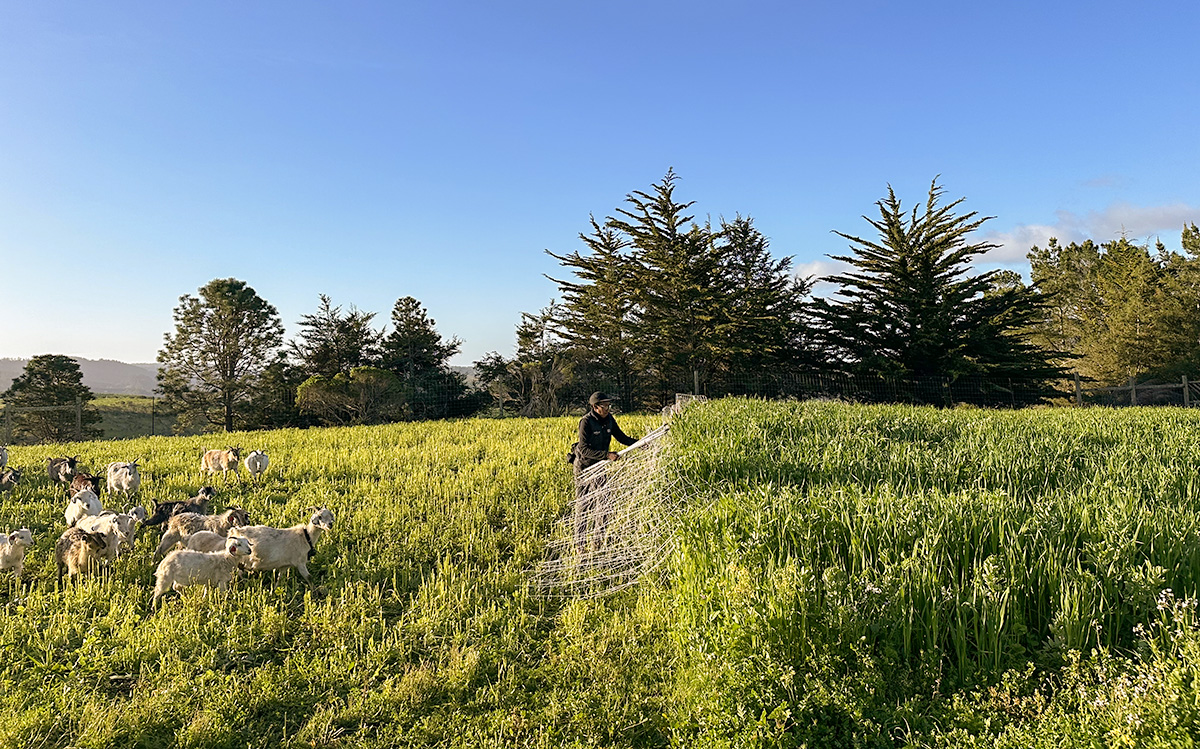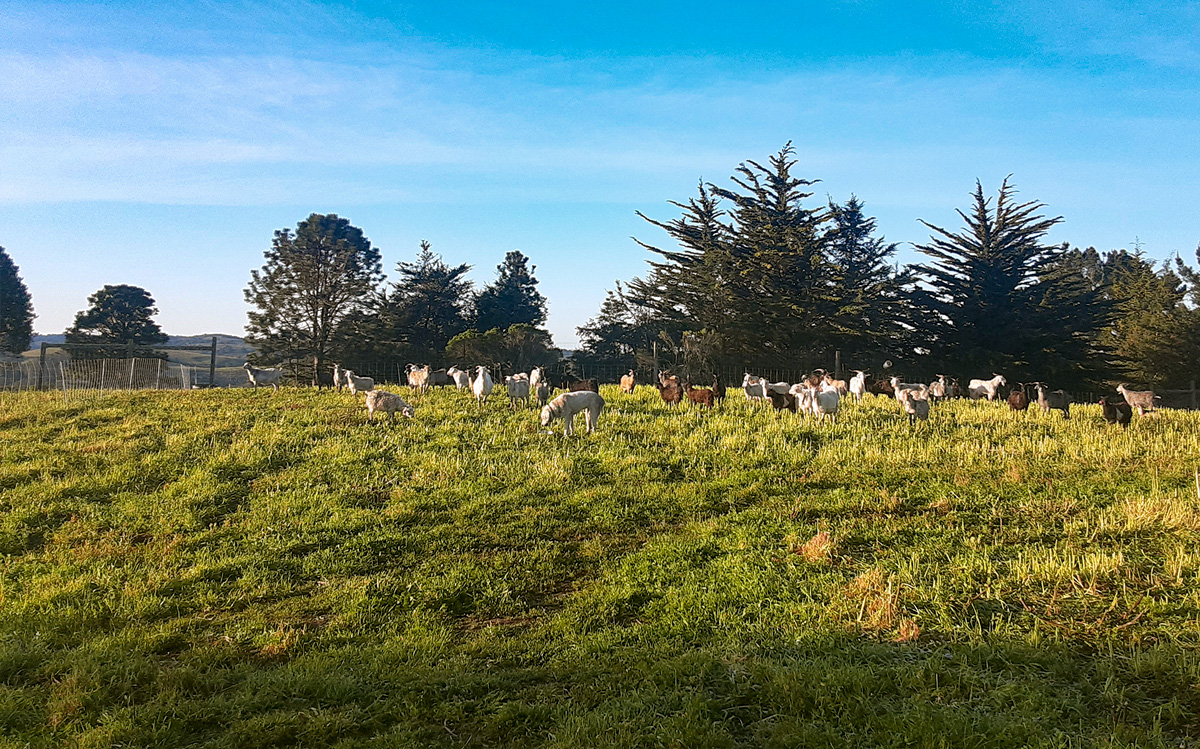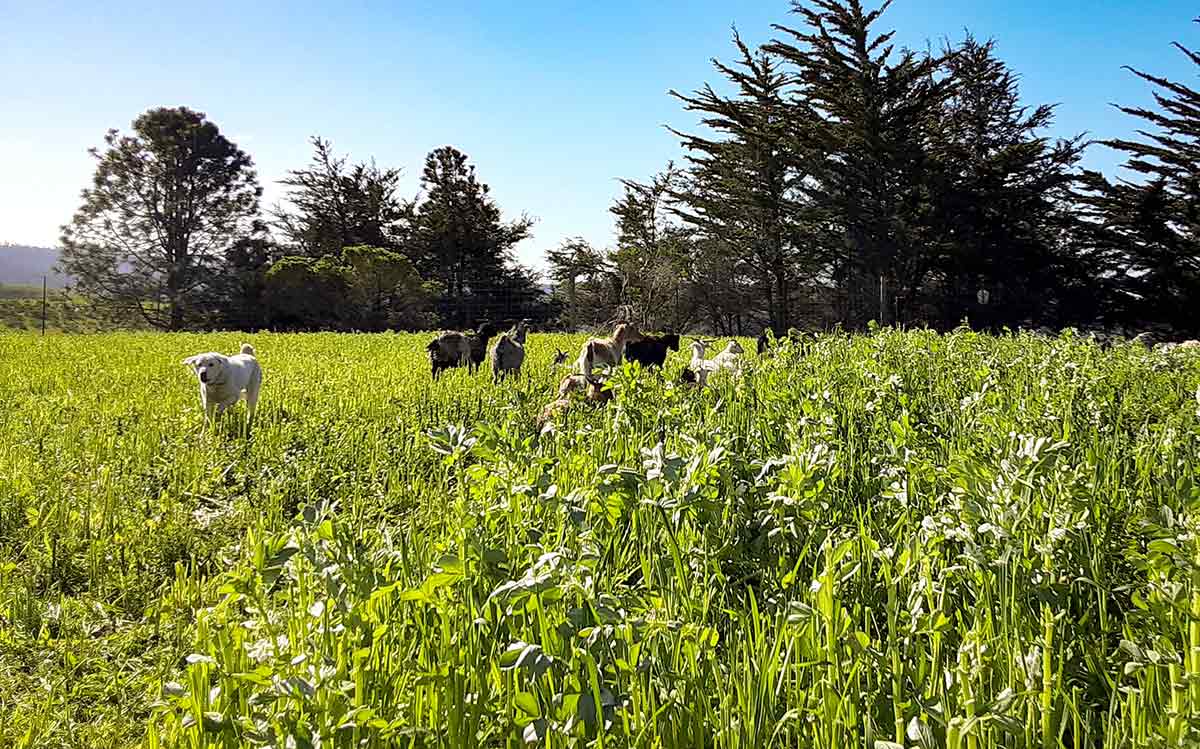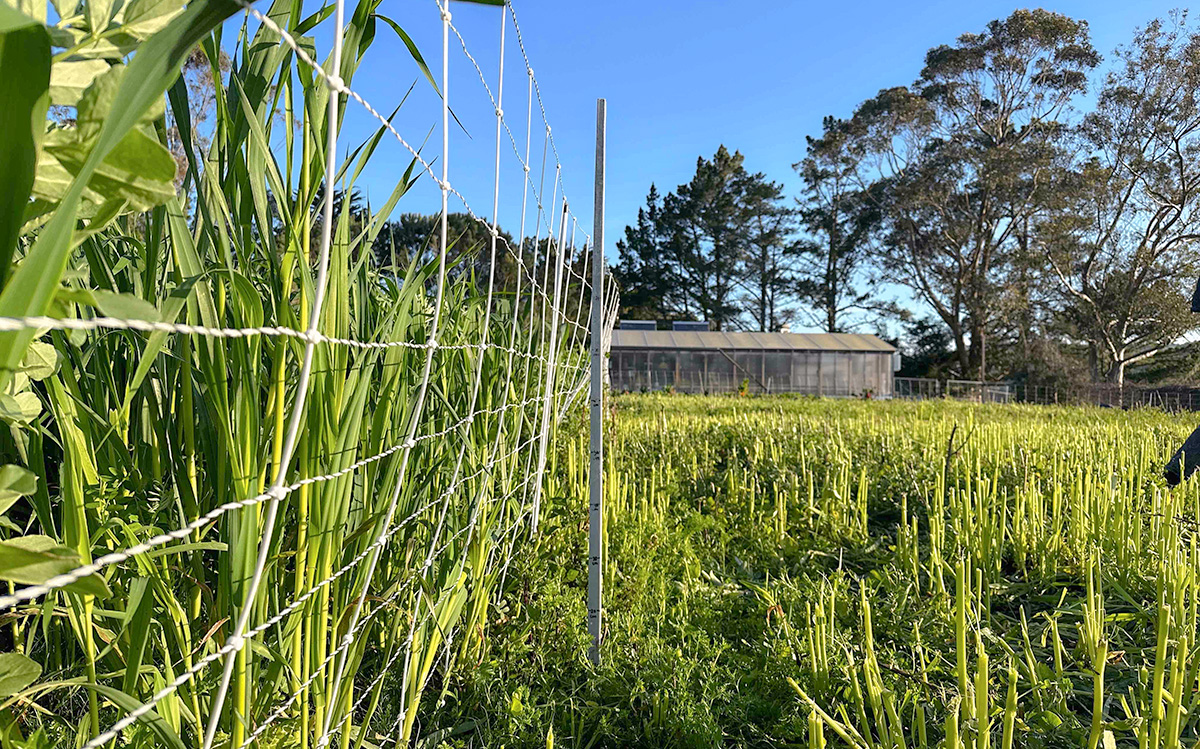The Land & Livestock team at TomKat Ranch utilizes cattle and goats on grasslands to bring our landscape back into balance. The soil and ecosystem regenerating potential of ruminants
Bring On the Goats – A Goat Grazing Cover Crop Pilot with Brisa Ranch
04/26/2023
By: Mukethe Kawinzi
 The Land & Livestock team at TomKat Ranch utilizes cattle and goats on grasslands to bring our landscape back into balance. The soil and ecosystem regenerating potential of ruminants, such as goats, can be harnessed in a variety of environments: rangelands, orchards, vineyards, and beyond. Last month, we had the opportunity to work alongside a local farm partner, Brisa Ranch, employing our goats to graze their cover crop—without the use of fossil fuels, chemicals, or mechanical equipment.
The Land & Livestock team at TomKat Ranch utilizes cattle and goats on grasslands to bring our landscape back into balance. The soil and ecosystem regenerating potential of ruminants, such as goats, can be harnessed in a variety of environments: rangelands, orchards, vineyards, and beyond. Last month, we had the opportunity to work alongside a local farm partner, Brisa Ranch, employing our goats to graze their cover crop—without the use of fossil fuels, chemicals, or mechanical equipment.
Winter was unusually chilly and wet on the California Coast, delaying the growth of grasses that the goat herd otherwise would have grazed in their last weeks of pregnancy. Fortunately, our approach to grazing is adaptive—when our plans are upended by the unexpected, we adjust accordingly. Last season’s rains were an opportunity to think creatively and, ultimately, cooperatively about meeting the nutritional needs of our herd while allowing the land the recovery it needed as sun, heat, and Spring returned more slowly than in years past.
Brisa Ranch grows a variety of organic fruits and vegetables on two farm sites in Pescadero, California. One of these locations is TomKat Ranch. Operated by Cristóbal Cruz Hernández, Verónica Mazariegos-Anastassio, and Cole Mazariegos-Anastassiou, Brisa has been committed to using regenerative practices since their founding in 2018. Companion and beneficials planting, manual and minimal tillage, and strategic crop rotations ensure a bountiful harvest for the local community while cultivating fertility and biodiversity below ground.
Cover cropping—generally defined as the planting of non-cash crops to improve soil health—has been an integral part of their devotion to promoting robust ecological processes. Cole has found that this technique “holds soil in place and prevents soil runoff, especially relevant in this year of heavy rains. When broken down, cover crops provide a source of green manure and help sequester carbon in the soil.” Cristóbal adds, “It’s also an effective way to eliminate and control weeds.”
As last year’s season came to a close, Brisa’s team seeded their field at TomKat to cultivate these benefits. Their cover crop grew swift and strong over the winter months, resulting in a dense plot of legumes. While many farm operations mow or spray cover crops before Spring planting, Brisa saw the opportunity to forego this more input-heavy traditional route. “We try to reduce our use of mechanical tools in order to limit soil disturbance. Goats grazing on the cover crop will minimize our use of equipment—namely tractor use—which is always beneficial,” Cristóbal affirms, adding, “We are able to then take advantage of the manure as a source of nutrition for the soil.”

Mukethe Kawinzi opens the fence as the goats patiently wait for the next round of cover crop grazing.
Thus, in March, TomKat’s goats grazed the winter crop in Brisa’s field—a verdant mix of vetch, bell beans, and peas chosen due to their prowess as nitrogen-fixers. The use of ruminants compounds the existing benefits of cover cropping: soil organic matter is increased from the stems, roots, and leaves of the plants as they decay and from the manure of the grazing animal. In this generative cycle of life, the ruminants are nourished and nourish the soil, and new crops are planted and later harvested to nourish our human community. [For those of you who like to get into the weeds: Brisa strictly follows USDA organic standards regarding livestock grazing and crop harvest.]
The goat herd entered the field with the natural curiosity of browsers, probing the novel forage before settling on favorites and, over the course of a week, devouring all that Brisa had sown. Existing plant species in and on the edges of the field like mustard, bunchgrasses, and yarrow allowed the herd to self-balance their rumens, or stomachs, in response to the new, abundant feed. In other words, goats have a natural instinct to diversify grazing to meet their nutritional needs. As always, we subdivided the field, moving the goats along regularly to distribute impact. Our team was ecstatic to see the goats roving through the cover crop with the fullest mouths to date. Brisa’s lush field offered the goats their first true taste of Spring as green-up slowly makes its way across our pastures.
Cole reflected, “When presented with the opportunity to integrate TomKat’s goat herd into our project, it seemed like a natural next step to do something that is mutually beneficial.” Working in collaboration with another operator allows farmers and landowners to introduce the benefits of grazing without managing their own livestock. Cristóbal agrees, “Although we would like to have animals as part of our operation, this is a great alternative.”
Livestock managers have much to gain from these partnerships. Depending on the operation and associated goals, using ruminants to graze cover crops can be a way to extend the grazing season, promote weight gain of livestock, minimize the use of hay and silage, and lower feeding costs. While our short trial included only goats, there is evidence of success using cattle and sheep to amplify the existent ability of cover cropping to enhance water infiltration, reduce erosion, promote biodiversity, and rehabilitate soil fertility, structure, and overall health.
In the season—and years—to come, Brisa’s team will track yields and quality closely as the field turns flush with radiant maize and piquant peppers. Ideally, the goats will return and, over time, boost microbial activity in the soil and thereby crop production. Vero expresses hope that the trial can be expanded to Brisa’s other growing sites. For TomKat Ranch, a rotation through Brisa’s plot gave our own pastures additional recovery time while augmenting the herd’s nutrition at the end of a tough winter.
Together, this small collaboration is one of many ways we hope to demonstrate that agriculture doesn’t have to degrade soils; in fact, it can restore them. As Cristóbal puts it, “We see this relationship between farm and ranch operations as an apt parallel to the types of symbiotic relationships we work to create in our farming practices—the ultimate goal to build a vibrant and biodiverse ecosystem.”
Resources like the Guide to Regenerative Grazing Leases—developed in partnership by California FarmLink and TomKat Ranch—provide guidance on drafting such contracts.
Additional Resources:
- Grazing Cover Crops: A How-to Guide from The Wallace Center’s Pasture Project
- Paicines Ranch Vineyard: Integrating Livestock as a Management Tool from UC ANR’s California Cover Crop Resources
- Cover Crops for Livestock Grazing from PennState Extension


